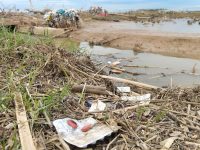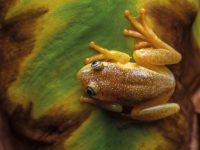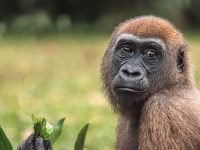From nuclear desert to evolutionary lab
The response of living organisms to Chernobyl’s ionising radiation
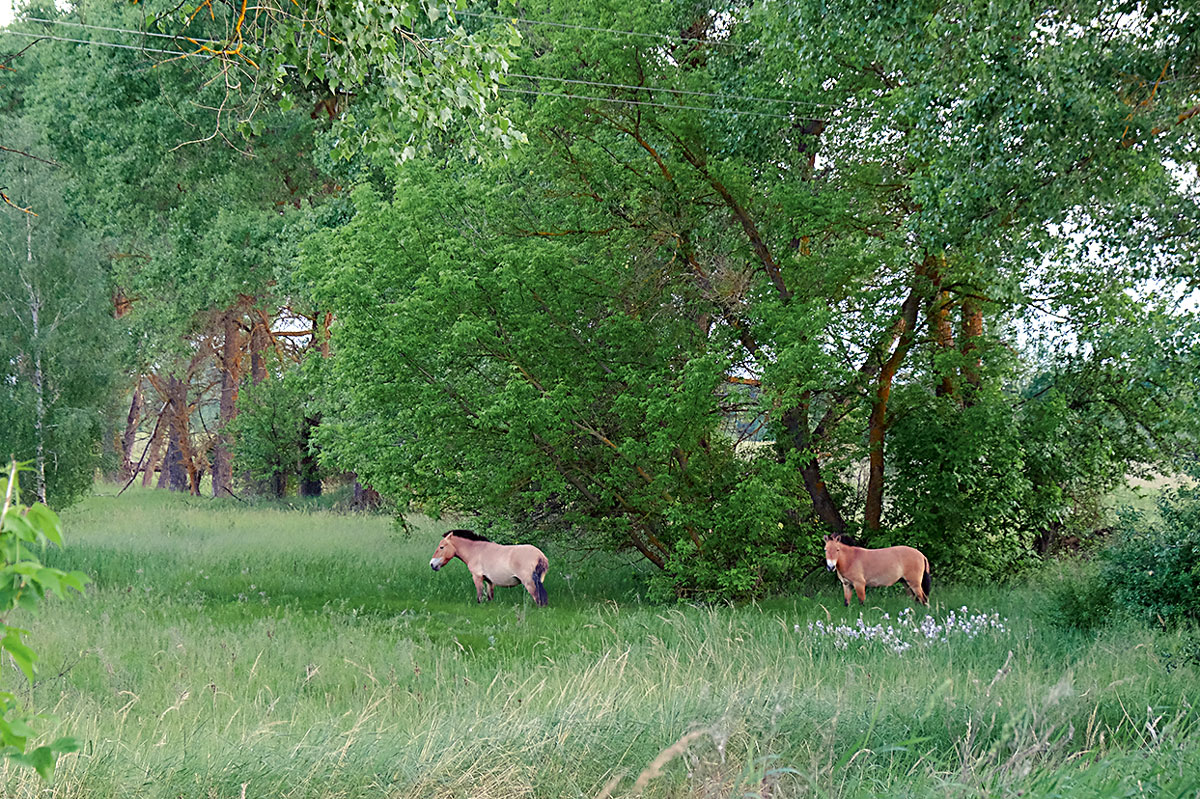
Przewalski’s horses were not present in Chernobyl at the time of the accident, but in the late 1990s, a herd of about 30 specimens was released so that their feeding activities would control the forest expansion. Twenty years after being introduced, around 150 Przewalski’s horses now live in the area and their breeding rate is quite elevated. / Germán Orizaola
The 1986 accident at the Chernobyl nuclear power plant in Ukraine caused the worst human-caused release of radioactive material in history. Initial forecasts considered that the area affected by radioactive contamination would be devoid of life for millennia. Three decades later, the biodiversity of the area has completely recovered and all the large mammals of Eastern Europe, as well as over 200 bird species, now live in Chernobyl. The mechanisms that allow organisms to live in this area are still the subject of study and controversy. There is currently no scientific consensus on the medium- and long-term impact of radiation on the nature of the area. Thus, basic research is required in Chernobyl to understand the effects that radioactive contamination had on biodiversity there. The area is also an excellent natural laboratory for studying eco-evolutionary processes in response to human activity.
Keywords: ecology, evolution, adaptation, mutation, radioactivity, Chernobyl.
We live surrounded by radioactivity, mainly from the cosmic rays that reach the Earth and from naturally-radioactive elements contained in our planet’s crust. In addition to natural radioactivity, living beings can be exposed to artificial radioactivity generated by human activity. Among other uses, artificial radioactivity is used in medical testing, weapons production, and the power-generation processes of nuclear power plants. Accidents such as those in the Chernobyl (Ukraine) and Fukushima (Japan) power plants in 1986 and 2011 respectively, are the most notable releases of radioactive material into the environment as a result of human action.
The Chernobyl nuclear accident
On 26 April 1986, at 1:23 p.m., reactor 4 of the Chernobyl nuclear power plant exploded during technical safety tests. Errors in the reactor’s design and in its handling led to the core overheating, causing an explosion that destroyed the reactor’s protective cover. Several fires occurred during the accident, mainly in the area of reactor’s graphite rods. These fires were active for nine days and dispersed enormous quantities of radioactive material. The radiation released into the environment during the accident is estimated to have been equivalent to 400 times the amount released by the atomic bomb dropped on Hiroshima (Japan) in 1945. This was, undoubtedly, the worst nuclear accident in history.
«As a result of the Chernobyl accident, a restricted Exclusion Zone of about 4,700 km2 was created, within which permanent human settlement was prohibited»
Immediately after the accident, containment and cleaning work began. All residents within a 30 km radius of the nuclear plant were evacuated. In total, during the subsequent operations, around 350,000 people were evacuated from areas near the plant in Ukraine and Belarus. As a result of the accident, a restricted Exclusion Zone of about 4,700 km2 was created, within which permanent human settlement was prohibited. These restrictions are still in place today.
The initial impact of the accident on the natural environment of the areas that received the highest doses of radiation was severe. The impact during the most acute phase of the accident was especially remarkable in a pine area adjacent to the nuclear power plant. The pines in that area died instantly and all their needles turned red, which gave the area the name it is known by today: The Red Forest. However, the radiation exposure to the plants and animals in other areas of the Exclusion Zone was much lower.
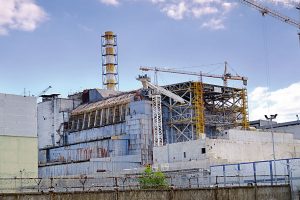
On 26 April 1986, reactor 4 of the Chernobyl nuclear power plant exploded in the middle of the night during technical tests. During the accident, the radiation released into the environment is estimated to have been equivalent to 400 times the amount released by the atomic bomb dropped on Hiroshima (Japan) in 1945. As a result of the accident, a restricted exclusion zone of about 4,700 km2 was created, within which permanent human settlement was prohibited. These restrictions are still in place today. The image shows a view of reactor 4 of the Chernobyl power plant photographed in September 2016. / Germán Orizaola
The general idea at the time of the accident was that the affected area would be devoid of life for hundreds or even thousands of years; that Chernobyl would become an uninhabitable nuclear desert. This vision was based on the long half-life of some of the radioactive isotopes released during the accident, which included plutonium-239 isotopes, with a half-life or around 24,000 years.
Today, 33 years after the accident, Chernobyl’s Exclusion Zone hosts populations of all large mammal species present in Eastern Europe (brown bears, wolves, Eurasian lynxes, Przewalski’s horses, moose, beavers, otters, etc.) as well as over 200 bird species, among many other animals. The forest area has spread to now occupy large areas formerly used as agricultural land. The area is clearly far from being a nuclear desert. This contradiction raises very interesting scientific questions: How can all these organisms live in Chernobyl? What mechanisms allow them to remain in an area like Chernobyl, contaminated with radioactive material?
Radioactive contamination in Chernobyl
To understand the effects that a nuclear accident such as the one in Chernobyl has on the environment, we need to know the nature of the radioactive isotopes released and their environmental distribution. Firstly, it is important to understand the type of radioactive substances released into the environment. One of the most abundant isotopes present immediately after the explosion was iodine-131, which generates high-energy beta radiation, is potentially very carcinogenic, and is especially linked to thyroid cancer. However, this radioisotope has a very short half-life of only eight days. In other words, just weeks after the accident, these isotopes had already disappeared from the area.
Other isotopes with half-lives of thousands of years, such as plutonium-239, generate low-energy alpha radiation with a low penetration capacity (i.e., it is even stopped by human skin), and so the danger of external irradiation by these radioisotopes is low. Currently, the main sources of contamination are caesium-137 and strontium-90 isotopes. These isotopes emit medium-energy gamma radiation and high-energy beta particles which have a greater penetration capacity and a half-life of about 30 years. That is, today, half of all the compounds of this type generated during the nuclear accident have already decayed and disappeared from the environment.
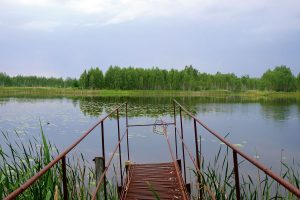
Radioactive contamination is unevenly distributed across the Chernobyl landscape. Currently, only a small part of the Exclusion Zone maintains high levels of radioactivity, and even within that area, radiation levels vary. The image shows Hluboke Lake, one of the most contaminated areas in Chernobyl’s Exclusion Zone. / Germán Orizaola
Another very important factor which is often forgotten but must be considered in Chernobyl, is the distribution of radioactive contamination through the landscape. Only a small part of the Exclusion Zone (about 30%) currently still has high radioactivity levels. Even within these areas, radiation levels can vary by several orders of magnitude on a scale of just a few meters. The patchwork distribution of radioactive contamination means that most organisms are not constantly exposed to high levels of radiation.
The effects of radiation on organisms
Ionising radiation, like the one generated in the Chernobyl nuclear accident, can damage cells. Cellular damage is generated when radioactive particles act on organic molecules, particularly DNA, either directly or indirectly. A cell’s DNA can be directly impacted by ionising radiation when alpha or beta radiation particles physically affect them and cause single or double breaks in its strands. Alternatively, DNA can be affected indirectly when radioactive particles interact with water molecules and other organic molecules and create free radicals that can react with DNA, in turn, causing structural damage.
«The general idea at the time of the accident was that the affected area would be devoid of life for hundreds or even thousands of years»
Such DNA damage has a very wide range of effects, and the level of damage depends on whether it is detected and repaired by cellular repair mechanisms. DNA repair can occur without generating any errors. But this process can also sometimes be imperfect, leading to the generation of mutations. In this second case, these mutational changes in the DNA nucleotide sequence can be synonymous (i.e., DNA sequence alterations that do not change the amino acid produced) and so, do not generate any functional effects. They can also be non-synonymous, in which case the amino acid sequence is modified and alterations in the structure and function of genes might result.
The accumulation of non-synonymous mutations in any organism is associated with changes in its metabolism and cell proliferation, as well as with alterations in gene expression, cellular senescence processes, or the development of carcinogenic responses. If the damage is abundant or uncorrected, cell maintenance and replication can be affected, which would alter cell functioning and could even lead to cellular death. High amounts of cell death in an organism can cause the death of an organism.
One aspect that is rarely considered, and one of great evolutionary relevance is that, given the high rate of random mutations generated by ionising radiation, this radiation also contributes to producing a much higher degree of population-scale genetic variability than usual. This rapid increase in genetic variability, combined with the presence a powerful selective agent like radiation, should favour intense natural selection processes. In addition, it can lead to the emergence of beneficial adaptive mutations that could allow organisms to survive radioactive contamination in the environment. In this sense, radiation itself might actually help to generate the genomic diversity needed to cope with radiation, and some studies have suggested the potential emergence of processes of adaptation to the chronic exposure to radioactive contamination present in Chernobyl (Galván et al., 2014; Møller & Mousseau, 2016).
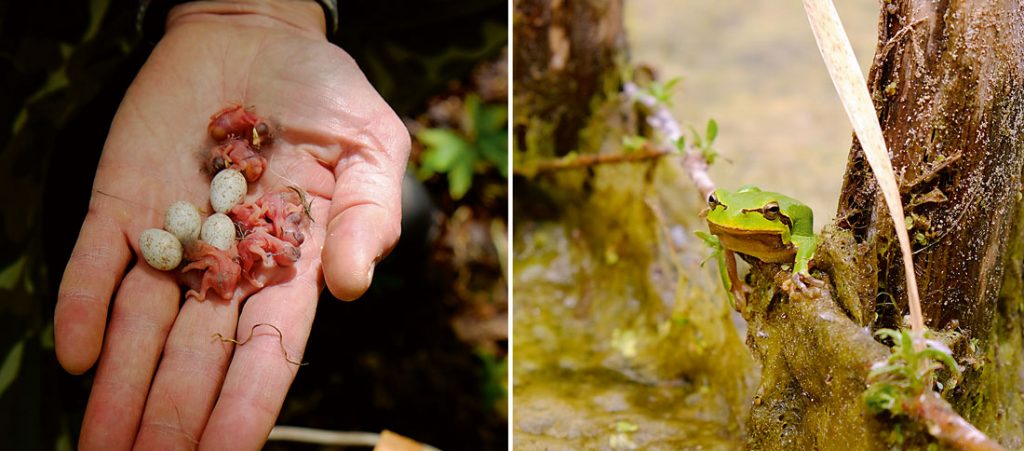
Although some studies focusing on birds found negative effects of the radiation in some individuals that lived in the most contaminated areas (for instance, a higher presence of white feathers or tumours among birds), more recent research did not find any significant radiation effects among a wide variety of organisms such as aquatic invertebrates, grasshoppers, or even birds. The image on the left shows a great tit (Parus major) in Chernobyl’s Red Forest in May 2017. On the right, Eastern tree frog (Hyla orientalis) in Chernobyl, photographed in June 2019. / Germán Orizaola
In short, the number and type of changes individuals experience in their cells as an effect of ionising radiation, as well as the associated selective processes, will eventually determine the level of impact that radiation has on these organisms and their populations.
Chernobyl’s wildlife and radiation
In the first few months after the Chernobyl nuclear power plant explosion, there were significant negative effects on the wildlife and vegetation of the areas most heavily affected by the radioactive contamination (UNSCEAR, 1996). An increase in mortality rate was registered for several groups of animals and plants, as were different morphological, physiological, and genomic alterations (Yablokov, Nesterenko, & Nesterenko, 2009). All these phenomena led to a population reduction in areas exposed to high levels of radiation.
Subsequent studies, which mainly focused on birds, found other negative effects of radiation at the individual level. For example, individuals living in the most contaminated areas presented morphological alterations such as an increase in leucism (the production of white feathers) and of tumours, decreased immune response levels, and several reproductive and genetic alterations (Møller & Mousseau, 2006). In addition, other work showed a lower abundance of several groups of animals in the areas with the highest radioactive contamination (Mousseau & Møller, 2014). However, many of these studies have been criticised for presenting serious methodological and analytical problems and have generated considerable controversy in the scientific community (Beresford, Scott, & Copplestone, 2019; Smith, 2007).
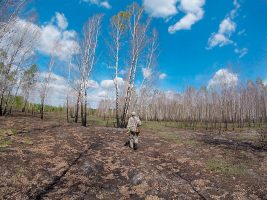
The initial impact of the accident on the natural environment of the areas that received the highest doses of radiation was severe. One of the best-known cases is the so-called Red Forest, a pine forest adjacent to the nuclear power plant. When the accident occurred, the pines in that area died instantly and all their needles turned red, giving the area its name. The image shows a researcher in Chernobyl’s Red Forest in May 2017. / Germán Orizaola
More recent studies found that the radiation had had no significant effects on a wide variety of aquatic invertebrates, grasshoppers, or even birds (Bonisoli-Alquati et al., 2018; Galván et al., 2014; Murphy, Nagorskaya, & Smith, 2011). Species such as the brown bear or the European bison, which were not present in Chernobyl at the time of the accident, have recolonised the area. Work carried out in the Belarusian part of the Exclusion Zone (the Polesie State Radioecological Reserve) between 1987 and 1996 also showed there had been a remarkable increase in the abundance of large mammals (moose, roe deer, boar, etc.) over time, and no relationship between radioactivity and the abundance of these species or that of a wolf population seven times larger in that region than in other natural reserves in the country (Deryabina et al., 2015).
One revealing case in the current situation of Chernobyl’s Exclusion Zone wildlife is that of Przewalski’s horses. These wild horses were not present at the time of the accident, but a herd of around 30 specimens was released in 1998–1999. The goal was that their feeding activities would control the forest expansion towards old cultivation lands. This population remains completely isolated within the Exclusion Zone, and they cannot reach any other horses of the same species coming from the outside. Nonetheless, 20 years after their introduction into Chernobyl, the population has increased fivefold and over 150 Przewalski’s horses now live in the Zone. Another example of the optimal condition of this population is its high reproduction rate, with 22 foals born in 2018.
The future of Chernobyl research
Conflicting results on the effects of radiation on Chernobyl’s wildlife make several points clear. It is evident that research in the Zone must continue. These studies should apply new methods and techniques and establish appropriately planned sampling designs. Molecular studies of the genome, epigenome, and metagenome are essential to determine the type of responses that living organisms develop against radiation and thus, correctly assess the current state of Chernobyl’s biodiversity. These techniques would also help to deepen our knowledge of the potential rapid adaptation processes that might come into play when exposed to chronic radioactive contamination.
Research in Chernobyl must also differentiate between the effects detected at the individual level and those involved in maintaining populations. It is not uncommon for particular environmental factors to have negative effects at the individual level, but the biological significance of these effects must also be determined. Assessing the magnitude of such effects in an ecosystem such as in Chernobyl is even more important in order to understand whether or not they affect the reproductive capacity of organisms and, consequently, their population maintenance.
In this context, we must examine any potential long-term radiation effects which do not interfere with the reproductive potential of organisms. For example, increased investment in cell repair and maintenance in organisms exposed to radiation could interfere with other biological functions and generate effects such as a reduced lifespan or an acceleration of the rate of ageing among individuals. However, these effects might allow them to maintain sufficient reproduction rates so that their population dynamics are unaffected.
«The absence of humans has been suggested as one of the key factors that have allowed the recolonisation by diverse and abundant animal populations»
Another aspect we need to consider in Chernobyl is the difference between effects caused by the radiation levels reached in 1986 – from which some systems have not recovered, as is the case with the Red Forest – and effects related with the current contamination levels. In the case of the Red Forest, considered by many studies as the main reference locality representative of the contaminated area, more caution is needed. The area is still under notable human influence because of its proximity to the nuclear power plant and moreover, it has also suffered several fires since 1986 and an evident change in its landscape because it has changed from being a pine forest to becoming an area dominated by birch trees. It is therefore important to differentiate all these ecological effects from those caused by the radiation itself.
When researching in Chernobyl, and also when communicating the results of this research to society, it is very important to clearly differentiate between those pertaining to the entire Chernobyl Exclusion Zone and those referring exclusively to the most highly-contaminated areas (a very small part of the Exclusion Zone). This will provide a realistic vision of what might be happening in the Zone at different radiation levels and is especially relevant because large areas of the Exclusion Zone have radioactive levels identical to the natural background radiation levels found on most of the planet.
Chernobyl also represents a clearexample of the complexity of working in research scenarios where a single factor is extraordinarily dominant. Many studies carried out in Chernobyl have exclusively examined the effect of radiation on the biology of living organisms, omitting any other relevant environmental factors, such as habitat diversity, the proximity of human activity areas, or the alterations the area has suffered since 1986. In order to advance our knowledge about the biodiversity in Chernobyl, it is crucial that future studies carried out in the Exclusion Zone consider these factors.
Chernobyl as a natural laboratory
Three decades after the Chernobyl nuclear power plant accident, permanent human settlement is still prohibited in a 4,700-km2 area around the plant, including Chernobyl’s Exclusion Zone in Ukraine and the Polesie State Radioecological Reserve in Belarus. The beneficial effect of the absence of humans in the region has been suggested as one of the key factors that have allowed the recolonisation by diverse and abundant animal populations even though areas contaminated by radioactive substances still exist.
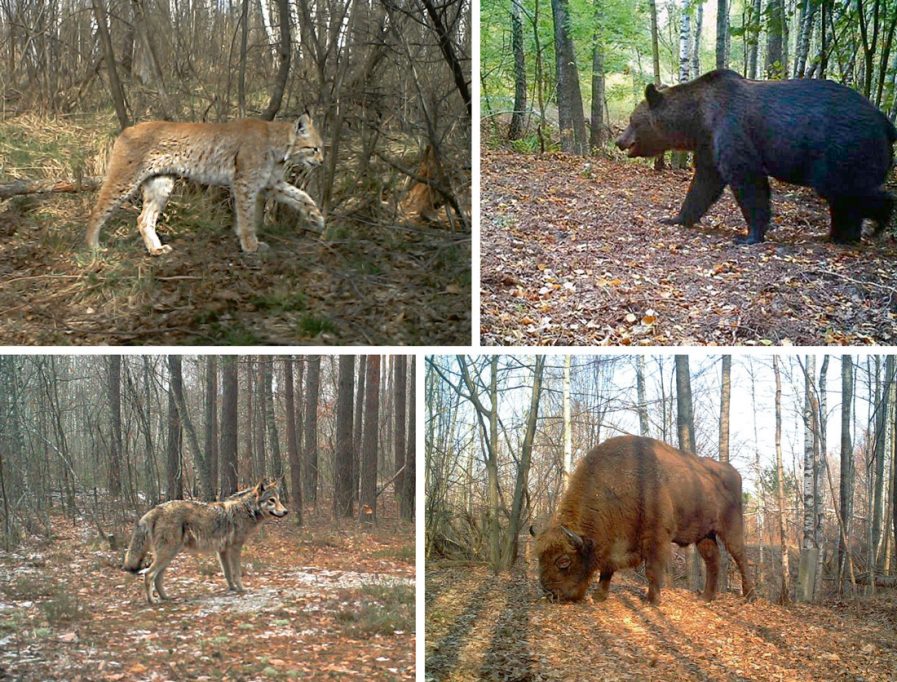
Species such as the brown bear (A) or the European bison (B), which were not present in Chernobyl at the time of the accident, have now recolonised the area. Other mammals living in the area are wolves (C), European lynx (D), and moose (E). More than three decades after the accident, Chernobyl’s Exclusion Zone is far from being a nuclear desert. In the future, this area should be protected so it can remain a preferential location for biodiversity research and conservation. / Sergey Gaschack & TREE project, University of Salford/ Centre for Ecology & Hydrology UK
From a scientific point of view, the absence of human interference turns Chernobyl into a unique natural laboratory in which the eco-evolutionary response of living organisms to an extreme anthropic environmental factor, radiation, can be studied. It is also an ideal site for studying ecological succession processes, rewilding initiatives, or the cascading effects that human depopulation can have on biodiversity. All these studies can also serve as a model for future work designed to analyse the response of living organisms to other sudden anthropic changes such as the alteration of natural habitats, urbanisation processes, or the impact of other pollutants.
Considering its scientific and social interest, Chernobyl should be protected in the future so it can remain a preferential location for biodiversity research and conservation. With that aim, the Exclusion Zone status as a Biosphere Radiological Reserve – as it was declared by the Ukrainian government in 2016 – should be maintained. Thus, an area that was expected to become a desert for life could come to be preserved as a unique refuge for living beings, one where response mechanisms to human action (and its absence) can still be studied.
REFERENCES
Beresford, N. A., Scott, M., & Copplestone, D. (2019). Field effects studies in Chernobyl’s Exclusion Zone: Lessons to be learnt. Journal of Environmental Radioactivity, in press (corrected proof available online). doi: 10.1016/j.jenvrad.2019.01.005
Bonisoli-Alquati, A., Ostermiller, S., Beasley, D. A. E., Welch, S. M., Møller, A. P., & Mousseau, T. A. (2018). Faster development covaries with higher DNA damage in grasshoppers (Chorthippus albomarginatus) from Chernobyl. Physiological and Biochemical Zoology, 91(2), 776–787. doi: 10.1086/696005
Deryabina, T. G., Kuchmel, S. V., Nagorskaya, L. L., Hinton, T. G., Beasley, J. C., Lerebours, A., & Smith, J. T. (2015). Long-term census data reveal abundant wildlife populations at Chernobyl. Current Biology, 25(19), 824–826. doi: 10.1016/j.cub.2015.08.017
Galván, I., Bonisoli-Alquati, A., Jenkinson, S., Ghanem, G., Wakamatsu, K., Mousseau, T. A., & Møller, A. P. (2014). Chronic exposure to low-dose radiation at Chernobyl favours adaptation to oxidative stress in birds. Functional Ecology, 28(6), 1387–1403. doi: 10.1111/1365-2435.12283
Mousseau, T. A., & Møller, A. P. (2014). Genetic and ecological studies of animals in Chernobyl and Fukushima. Journal of Heredity, 105(5), 704–709. doi: 10.1093/jhered/esu040
Møller, A. P., & Mousseau, T. A. (2006). Biological consequences of Chernobyl: 20 years on. Trends in Ecology and Evolution, 21(4), 200–207. doi: 10.1016/j.tree.2006.01.008
Møller, A. P., & Mousseau, T. A. (2016). Are organisms adapting to ionizing radiation at Chernobyl? Trends in Ecology and Evolution, 31(4), 281–289. doi: 10.1016/j.tree.2016.01.005
Murphy, J. F., Nagorskaya, L. L., & Smith, J. T. (2011). Abundance and diversity of aquatic macroinvertebrate communities in lakes exposed to Chernobyl-derived ionising radiation. Journal of Environmental Radioactivity, 102(7), 688–694. doi: 10.1016/j.jenvrad.2011.04.007
Smith, J. (2007). Is Chernobyl radiation really causing negative individual and population-level effects on barn swallows? Biology Letters, 4(1), 63–64. doi: 10.1098/rsbl.2007.0430
UNSCEAR. (1996). Effects of radiation on the environment. Sources and effects of ionizing radiation (UNSCEAR 1996 Report to the General Assembly, with Scientific Annexes). New York: United Nations Scientific Committee on the Effects of Atomic Radiation.
Yablokov, A. V., Nesterenko, V. B., & Nesterenko, A. V. (2009). Consequences of the Chernobyl catastrophe for the environment. Annals of the New York Academy of Sciences, 1181(1), 221–286. doi: 10.1111/j.1749-6632.2009.04830.x

